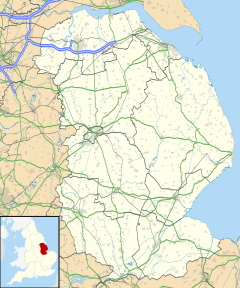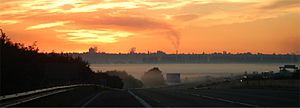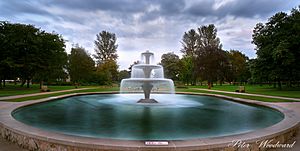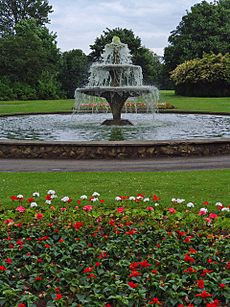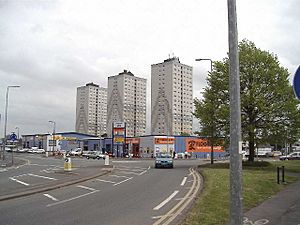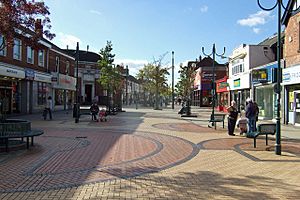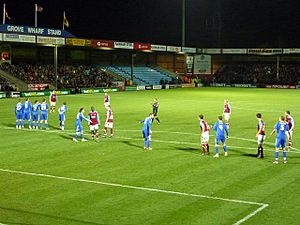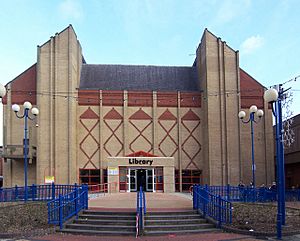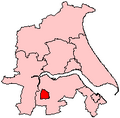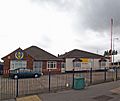Scunthorpe facts for kids
Quick facts for kids Scunthorpe |
|
|---|---|
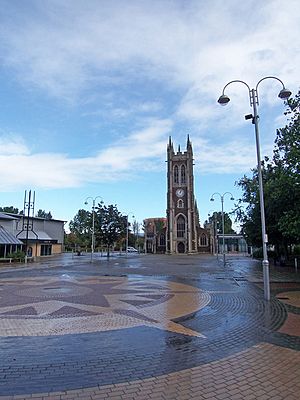 Church Square in the town centre |
|
| Population | 82,334 (2016) |
| OS grid reference | SE893102 |
| • London | 145 mi (233 km) S |
| Unitary authority | |
| Ceremonial county | |
| Region | |
| Country | England |
| Sovereign state | United Kingdom |
| Post town | SCUNTHORPE |
| Postcode district | DN15 – 17 |
| Dialling code | 01724 |
| Police | Humberside |
| Fire | Humberside |
| Ambulance | East Midlands |
| EU Parliament | Yorkshire and the Humber |
| UK Parliament |
|
Scunthorpe is an industrial town in the unitary authority of North Lincolnshire in Lincolnshire, England of which it is the main administrative centre. Scunthorpe had an estimated total population of 82,334 in 2016. A predominantly industrial town, the town is the United Kingdom's largest steel processing centre and is also known as the "Industrial Garden Town". It is the third largest settlement in Lincolnshire, after Lincoln and Grimsby. The Member of Parliament for Scunthorpe is Conservative politician Holly Mumby-Croft.
Contents
History
Scunthorpe as a town came into existence due to the exploitation of the local ironstone resources, and subsequent formation of iron works from the 1850s onwards. The regional population grew from 1,245 in 1851 to 11,167 in 1901 and 45,840 in 1941. During the expansion Scunthorpe expanded to include the former villages of Scunthorpe, Frodingham, Crosby, Brumby and Ashby. Scunthorpe became an urban district in 1891, merged as 'Scunthorpe, Brumby and Frodingham Urban District' in 1919, and became a municipal borough in 1936.
Etymology
The town appears in the Domesday Book (1086) as Escumesthorpe, which is Old Norse for "Skuma's homestead", a site which is believed to be in the town centre close to where the present-day Market Hill is located.
Geology
Scunthorpe is located close to an outcrop of high-lime-content ironstone (~25% iron average) from a seam of the Lias Group strata which dates from the Early Jurassic period and runs north-south through Lincolshire. Ironstone was mined by open cast methods from the 1850s onwards, and by underground mining from the late 1930s. In the 1970s the steel industry in Scunthorpe transitioned to use of ores imported from outside the UK with higher iron content. Underground mining in the area ceased in 1981.
Scunthorpe was close to the epicentre (this was centred at Middle Rasen) of one of the largest earthquakes experienced in the British Isles on 27 February 2008, with a magnitude of 5.2. Significant shocks were felt in Scunthorpe and the surrounding North Lincolnshire area. The main 10-second quake, which struck at 00:56 GMT at a depth of 9.6 mi (15.4 km), was the second largest recorded in the British Isles. In 1984 a quake with a magnitude of 5.4 struck north Wales.
Geography
Scunthorpe lies on an escarpment of ridged land (the Lincoln Cliff) which slopes down towards the Trent. The surrounding environs are largely low-lying hills and plains. Although the town itself is heavily industrial it is surrounded by fertile farmland and wooded areas. In terms of general location it lies a mile east of the River Trent, 8 miles (13 km) south of the Humber Estuary, 15 miles (24 km) west of the Lincolnshire Wolds and 25 miles (40 km) north of Lincoln. The town is situated at the terminus of the M181, 42 miles (68 km) from Sheffield. Nearby towns and cities are Hull (18 miles northeast), Doncaster (20 miles west), Grimsby (22 miles east) and York (46 miles northwest). From its position at the heart of North Lincolnshire it is roughly 5 miles (8.0 km) south/south-east to Lincolnshire proper, 10 miles (16 km) west to South Yorkshire, 8 miles (13 km) north by northwest to the East Riding of Yorkshire and 15 miles (24 km) east to North East Lincolnshire
Climate
Like most of the United Kingdom, Scunthorpe has an oceanic climate (Köppen: Cfb).
| Climate data for Scunthorpe | |||||||||||||
|---|---|---|---|---|---|---|---|---|---|---|---|---|---|
| Month | Jan | Feb | Mar | Apr | May | Jun | Jul | Aug | Sep | Oct | Nov | Dec | Year |
| Average high °C (°F) | 5.8 (42.4) |
6.1 (43.0) |
8.9 (48.0) |
11.4 (52.5) |
15.2 (59.4) |
18.4 (65.1) |
20.3 (68.5) |
20.1 (68.2) |
17.7 (63.9) |
13.8 (56.8) |
8.9 (48.0) |
6.5 (43.7) |
12.8 (55.0) |
| Average low °C (°F) | 0.6 (33.1) |
0.5 (32.9) |
1.9 (35.4) |
3.6 (38.5) |
6.5 (43.7) |
9.5 (49.1) |
11.4 (52.5) |
11.4 (52.5) |
9.5 (49.1) |
6.8 (44.2) |
3.2 (37.8) |
1.4 (34.5) |
5.5 (41.9) |
| Average precipitation mm (inches) | 48 (1.9) |
38 (1.5) |
48 (1.9) |
48 (1.9) |
51 (2.0) |
53 (2.1) |
53 (2.1) |
64 (2.5) |
48 (1.9) |
48 (1.9) |
56 (2.2) |
53 (2.1) |
610 (24.0) |
Transport
Scunthorpe railway station lies on the South TransPennine Line which has trains from Manchester Airport to Cleethorpes. Scunthorpe station (SCU), has two platforms and runs three different services. Platform 1 serves the TransPennine Express Cleethorpes route, whilst Platform 2 serves the TransPennine Express Manchester Airport route, and the Northern Doncaster route. The Northern train is the local stopping service, which runs from Monday-Saturday, and is served by TransPennine Express at the first and last service of the day. For local people traveling to Doncaster, it is often preferred to use the TransPennine Express services, as they go direct into Doncaster, and do not rely upon the 1980s pacer trains that Northern run today. The station is operated by TransPennine Express, and was made more accessible when lifts were added in 2019.
The town lies five miles (8 km) north of the M180, and the M181 terminates Glanford Park, on the outskirts of the town. Before this motorway was opened in 1979, all the east–west goods traffic took the A18 to Grimsby. Humberside Airport is a short drive to the east along the M180. The town's bus station is off Fenton Street. The bus station is predominantly used by Stagecoach in Lincolnshire that operate services within and out of the town along with Hornsby Travel. East Yorkshire operate services to Hull and Goole.
Religion
The church of St John the Evangelist, in Church Square, was completed in 1891 and consecrated on 15 April that same year. The church was built, at a cost of £20,000 (equivalent to £1,570,000 as of 2021) on land given by Lord St Oswald.
Built of Frodingham ironstone, and comprising a nave with five bays and a clerestory, a chancel, north and south aisles, two porches and a tower, it could accommodate up to 500 worshippers. It was designed by J. S. Crowther in the perpendicular style. The original striking clock was installed, in 1890 by William Potts and Sons of the Guildford Clock Works in Leeds. In 1897 quarter chimes were added. The peal of eight bells were hung in 1893, in memory of the Lord St Oswald. The organ, built in London, cost £1,000.
The final church service was held on 29 April 1984 and the building is now an arts centre.
Culture
The North Lincolnshire Museum is on Oswald Road, near the railway station. The former church of St John the Evangelist is now the 20–21 Visual Arts Centre. The Plowright Theatre, named after Joan Plowright, is on Laneham Street (off the west end of High Street and also near the railway station). It was built in 1958 as Scunthorpe Civic Theatre. The Baths Hall, reopened in 2011, a 1,700 capacity venue also hosts visiting musical and theatrical events.
The Scunthorpe Co-operative Junior Choir from Scunthorpe won the title of BBC Radio 3 Choir of the Year 2008 at the Grand Finals on 7 December 2008 at the Royal Festival Hall, London. The main choir is made up of 90 members aged between 9 and 19 years whilst also having two training choirs taking children as young as 3 years old. They have made several CDs, perform numerous concerts in the area and further afield, have been subject of documentaries and are internationally renowned as having travelled the world.
Twinned municipalities
Economy
Steel industry
The Iron industry in Scunthorpe was established in the mid 19th century, following the discovery and exploitation of middle Lias ironstone east of Scunthorpe. Initially iron ore was exported to iron producers in South Yorkshire. Later, after the construction of the Trent, Ancholme and Grimsby Railway (1860s) gave rail access to the area iron production in the area rapidly expanded using local ironstone and imported coal or coke. Rapid industrial expansion in the area led directly to the development of the town of Scunthorpe, eventually incorporating several other former hamlets and villages, in a formerly sparsely populated entirely agricultural area.
From the early 1910s to the 1930s the industry consolidated, with three main ownership concerns formed – the Appleby-Frodingham Steel Company, part of the United Steel Companies; the Redbourn Iron Works, part of Richard Thomas and Company of South Wales (later Richard Thomas and Baldwins); and John Lysaght's Normanby Iron Works, part of Guest, Keen and Nettlefolds.
In 1967 all three works became part of the nationalised British Steel Corporation (BSC), leading to a period of further consolidation – from the 1970s the use of local or regional ironstone diminished, being replaced by imported ore via the Immingham Bulk Terminal. Conversion to the Linz-Donawitz process (or "basic oxygen" process) of steel making from the open hearth process took place from the late 1960s onwards and was complete by the 1990s. Both the Normanby Park and the Redbourn works closed in the early 1980s.
Following privatisation in 1988 the company, together with the rest of BSC, became part of Corus (1999), later Tata Steel Europe (2007). In 2016 the long products division of Tata Steel Europe was sold to Greybull Capital with Scunthorpe as the primary steel production site.
In 2012 the steel industry remained the major employer in the area and its largest operator was Tata Steel Europe. The number employed in the industry fell from 27,000 at its height to around 4,500 (excluding outside contractors) by the mid 2010s. The steel works and the former ironstone workings have both had large scale detrimental environmental effects in the district, including air pollution and subsidence.
In May 2019, after a drop in future orders, and a breakdown in rescue talks between the government and the company's owner, Greybull, British Steel Limited entered insolvency.
Industries associated with the steelworks include metal engineering as well as a BOC plant.
Other industries
Although the historical predominance of the steel industry made Scunthorpe a virtual monotown, there are other industries in the town. These include food production, distribution and retailing. North of the town next a waste management firm, Bell Waste Control, which services the majority of industry in Scunthorpe and the surrounding areas. On the Foxhills Industrial Park, north of the A1077 northern bypass, are many distribution companies, notably a large building owned by the Nisa co-operative type mutual organisation which has its UK headquarters there. Also on the Foxhills Industrial Park is a 500,000 square foot factory occupied by Wren Kitchens, employing 350 full-time workers.
2 Sisters Food Group have a large chicken processing plant in the town. Key Country Foods produces meat products on an industrial scale. The Sauce Company produces sauces, soups and other foodstuffs for the catering and supermarket sectors. Ericsson Mobile Platforms produces printed circuit boards for the telecommunications industry. There are a number of other firms, mostly involved in manufacturing and light engineering.
In the 2001 census 19.3% of the working age population were economically inactive.
Retail
Scunthorpe has two major shopping centres, effectively a single site: the Foundry Shopping Centre and the Parishes Centre. The former was constructed in the late 1960s/early 1970s during a wholesale reconstruction of the old town; the latter was constructed in the early part of the 2000s decade on the site of the town's old bus station. There are also many well known retailers on High Street. On 6 January 2011 Marks and Spencer closed their High Street store after 80 years of trading, but a new Marks and Spencer store opened near the football ground in 2014.
However the size of the remaining retail units reflects the size of the area's population and with larger shopping facilities within reasonable travelling distance in Grimsby, Hull, Doncaster, Lincoln, Leeds and at Meadowhall Centre, Sheffield.
The once-thriving market, mostly under cover in market halls just to the north of the Central Library, at the eastern end of the High Street, had shrunk noticeably in the last ten years, and has now moved to the new St John's Market, close to the Bus Station. The opening date was 22 March 2019.
All of the big food retailers are represented in the area. There is a Tesco Extra, and an Aldi (in the former Toys R Us unit) opposite the football ground, while Sainsbury's (formerly a Safeway) have their store on the site of the old Scunthorpe United stadium, The Old Show Ground. Morrisons have a store at the bottom of Mortal Ash Hill (known locally as "Motlash") (A18 road) at the Lakeside Retail Park, on the eastern entrance to the town, while Asda have a store on Burringham Road. In 2011 Asda opened another store in the former Netto, on Charlton Street.
On 24 October 2014 Marks and Spencer's returned to the town after almost a 4-year absence. The store is housed in a purpose built location at the North Lincolnshire Shopping Centre, beside Glanford Park. Debenhams, Boots, B&M Bargains, Costa Coffee and Subway have also opened stores at the centre.
Sport
Football
The town has a Football League club, Scunthorpe United (nicknamed "The Iron") who play at Glanford Park. For most of its existence in the professional game (since only 1950) it has been in the lower leagues of the English Football League. At the end of the 2006–7 season they won promotion to the Football League Championship as champions of League One, amassing a total of 91 points, being promoted at home to Huddersfield Town: having been top since January: despite being outsiders for a considerable amount of that time, and being promoted with 3 games to spare. This being the first time they have played at this level for 44 years. This was to last just one season as the club were relegated on 12 April 2008, with three games to spare, away to Crystal Palace. However, they returned to the Championship after one season, winning the League One playoffs in May 2009.
The team currently plays in League Two after being relegated in 2019 from League One.
England stars Kevin Keegan and Ray Clemence both played for Scunthorpe United in the early 1970s before being signed for Liverpool, where they made their names. Former England cricket captain Ian Botham played a number of games for the club, being a resident of nearby Epworth at that time and in an attempt to keep fit during the winter months. The team mascot is called the "Scunny Bunny".
Semi-professional sides within the Town or greater town boundaries include Appleby Frodingham and Bottesford Town, Local teams play in the Scunthorpe & District Football League.
Rugby
Scunthorpe Rugby Club play in the National League 2 North, the fourth tier of the English rugby union system. Their home ground is at Heslam Park, close to Brumby on Ashby Road. Scunthorpe Barbarians play rugby league also at Heslam Park.
Motorsports
Scunthorpe also has a speedway team known as the Scunthorpe Scorpions who compete in the British Premier League, the sport's second tier in Britain. The speedway team has been running since 2005 and won a grand slam of the Conference League trophies in both 2006 and 2007 before claiming the Premier League title in 2012, alongside this Speedway world champion Tai Woffinden was born in Scunthorpe, riding for the Scunthorpe Scorpions in his youth. It runs at the Eddie Wright Raceway, which is a mile north of the town on Normanby Road (B1430).
The Eddie Wright Raceway is also host to the sport of stock car racing, the town has featured stock car racing at two other venues in its past, 2009 saw a return to the town of the oval racing sport
- Scunthorpe Scorpions – Premier League team
- Scunthorpe Saints – National League (formerly Conference League) team
Athletics
The Appleby-Frodingham Athletic Club uses the 34-acre (140,000 m2) site near the Civic Centre for many types of sport. They have a clubhouse and also use Brumby Hall next-door. The site includes a 3G football pitch and an artificial Astro hockey pitch, along with several grass football pitches and an area for cricket. There is also the Scunthorpe and District Athletics Club. They train at Quibell Park Stadium, Scunthorpe's athletic track on Brumby Wood Lane named after David Quibell, the town's former Labour MP. Around the running track is a cycle track used by Polytechnic Cycle Club.
The leisure centre was on Carlton Street opposite the bus station via a footbridge. After The Pods opened this was demolished. The Scunthorpe Anchor swimming club are based at the Riddings Pool on Enderby Road next to South Leys School.
The Pods, a leisure centre near Central Park, opened in 2011 costing an estimated £21 million. Facilities include an 8 lane 25m pool and a separate shallow pool, a state of the art gym, a dance studio, a large sports hall with climbing wall, a creche and a cafe.
As part of the project, Central Park is being improved. These expensive improvements are also in their final stage. North Lincolnshire Council's website regularly show photographs and videos of how the work is progressing.
Scunthorpe has two parkruns. One in Central Park and another at Normanby Hall
American Football
The Scunthorpe Alphas who were formed in 2018 play their home games at Quibell Park Stadium and for 2021 will complete in the BAFA National Leagues Division Two. The town's previous American football side was the Scunthorpe Steelers who folded in 1990.
Education
Scunthorpe's primary schools include Berkeley Primary School, Outwood Juniors Academy Brumby, Crosby Primary School, Frodingham Infant School, Oasis Academy Henderson Avenue, Oasis Academy Parkwood, St Augustine Webster's Catholic Voluntary Academy, St Bernadette's Catholic Primary Voluntary Academy, St Peter and St Paul CofE Primary School, Scunthorpe CofE Primary School, The Grange primary, Oakfield Primary School and Westcliffe Primary School.
Secondary schools within Scunthorpe include Outwood Academy Brumby on Cemetery Road, and Outwood Academy Foxhills on Foxhills Road. Frederick Gough School is to the south of the town in Bottesford. Melior Community Academy, to the east of the town, was formed by the merger of South Leys Business & Enterprise College on Enderby Road with Thomas Sumpter School. St Bede's Catholic Voluntary Academy on Collum Avenue is the main Roman Catholic secondary school for the area, while the St Lawrence Academy on Doncaster Road is a Church of England secondary school; it was formerly known as High Ridge Specialist Sports College and became the town's first academy in September 2008. Engineering UTC Northern Lincolnshire opened in 2015 and is a university technical college for pupils aged 14 to 19. St Hugh's Communication and Interaction Specialist College is a school for pupils aged 11–19 with moderate to complex learning needs associated with physical and social problems.
Scunthorpe has two study support centres, Study United FC and Study Heslam, set up with funding from the government's Playing for Success scheme. These are based at Glanford Park, the home of Scunthorpe United Football Club and Heslam Park, home of Scunthorpe rugby and cricket clubs.
Further education
John Leggott Sixth-Form College (JLC) is on West Common Lane and North Lindsey College is close by on Kingsway (A18). Scunthorpe's only university is UCNL, which offers undergraduate courses to approximately 1,500 students.
Notable people
- Roy Axe, car designer for Chrysler and Rover was born in Scunthorpe
- Darren Bett, television weather presenter
- Ryan J. Brown, actor and screenwriter
- James Cobban, English educator and headmaster, as well as a prominent lay leader in the Church of England
- Richard G. Compton, Oxford professor, was born in Scunthorpe
- Neil Cox Manager of Scunthorpe United FC
- Howard Devoto, singer with the Buzzcocks and Magazine
- Kevin Doyle, actor who has appeared in Coronation Street and Downton Abbey
- Stephen Fretwell, singer-songwriter
- Jeff Hall, English footballer who played as a right back for Birmingham City and England
- Tony Jacklin, golfer, was born in Scunthorpe
- Dave Ladley, professional darts player
- Reece Mastin, singer and winner of 2011 X-Factor Australia, was born in Scunthorpe
- Iain Matthews, singer with Fairport Convention
- Rob McElnea, 500cc grand prix rider, team manager of the Virgin Mobile Yamaha team
- Ross McLaren, actor, was born in Scunthorpe
- Graham Oates, is an English former professional footballer. He played as a midfielder.
- Alfie Moore, comedian.
- John Osborne, writer. Creator of Sky 1 sitcom After Hours as well as six half-hour Radio 4 storytelling shows.
- Dame Joan Plowright, award-winning actress, born in nearby Brigg, attended Scunthorpe Grammar School
- David Plowright, television executive and producer
- Jake Quickenden, former contestant on The X Factor, I'm a Celebrity...Get Me Out of Here! and Dancing on Ice
- Martin Simpson, guitarist and singer-songwriter, was born in Scunthorpe
- Sam Slocombe, professional football player for Notts County F.C. and formerly of local side Scunthorpe United, was born in the town
- Liz Smith, actress
- Graham Taylor, former England manager grew up in the town.
- Brian Tierney, published historian and medievalist
- Alan Walker, musicologist and biographer of Franz Liszt, was born in Scunthorpe
- Albert 'Lal' White, Olympic cycling silver medallist at the 1920 Antwerp games. Was the subject of the opera: Cycle Song.
- Tai Woffinden, speedway world champion
Images for kids
-
Scunthorpe within Humberside (1974–1996)
See also
 In Spanish: Scunthorpe para niños
In Spanish: Scunthorpe para niños


